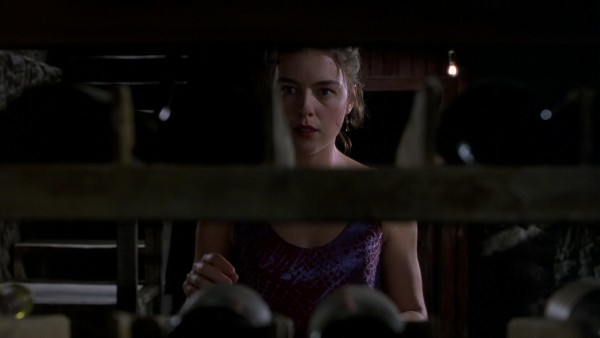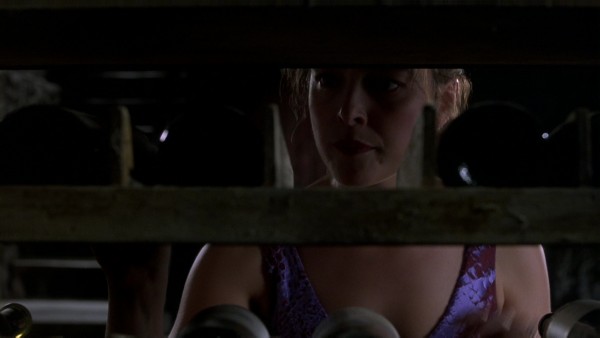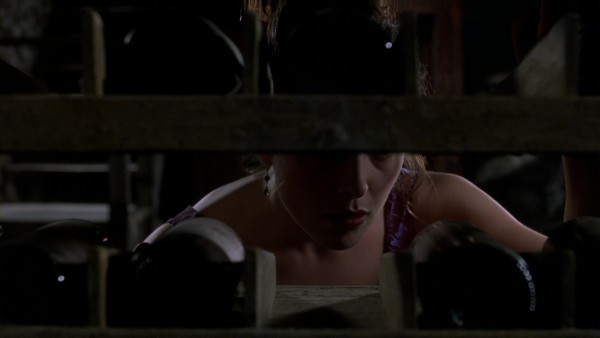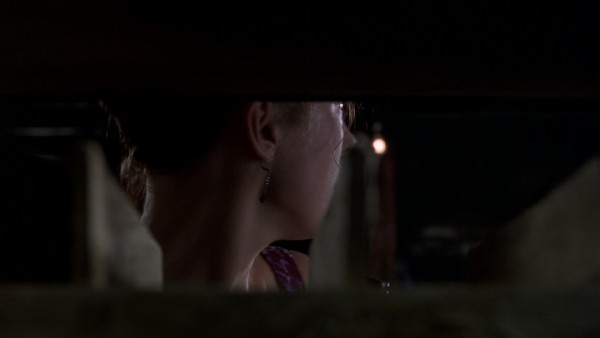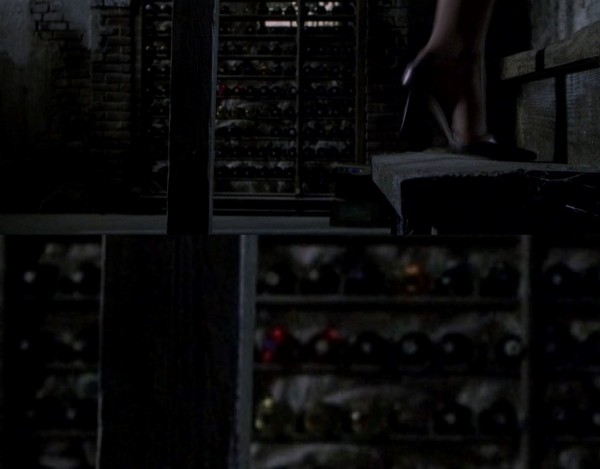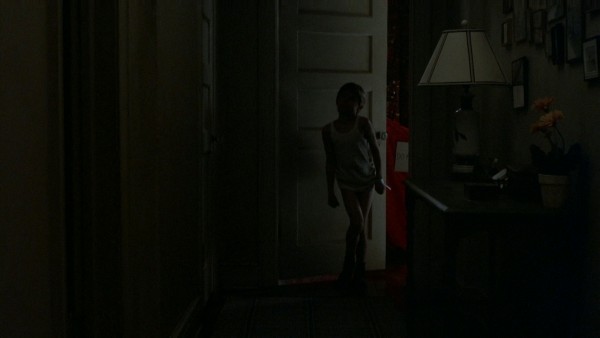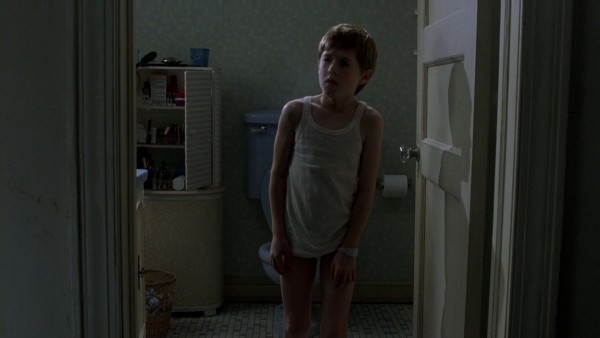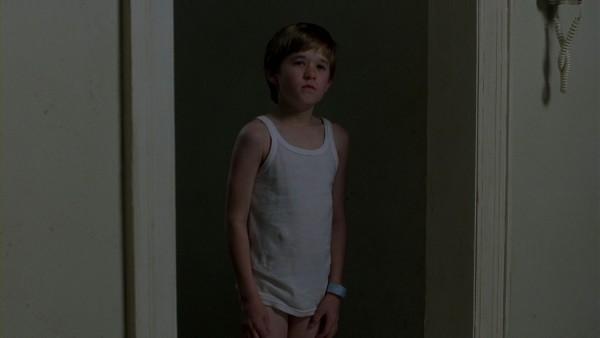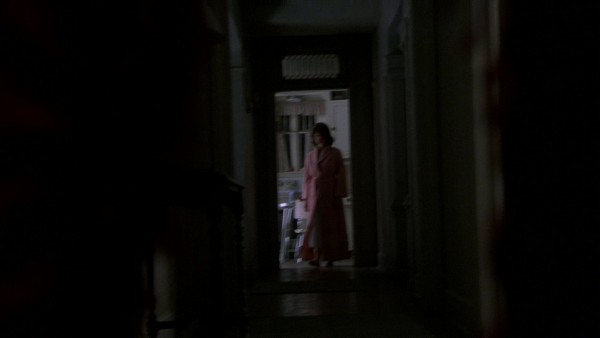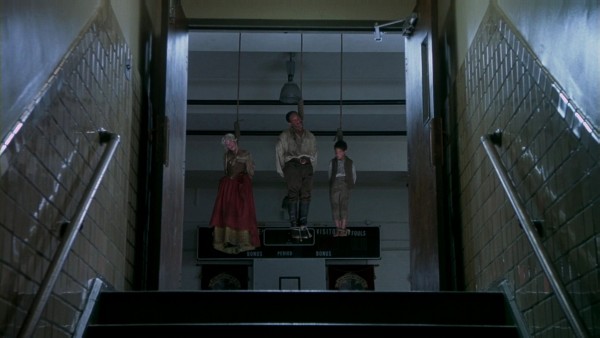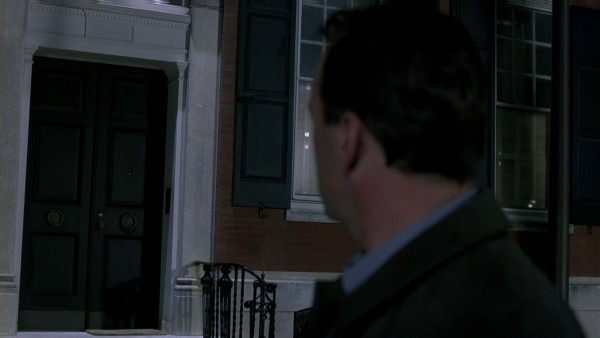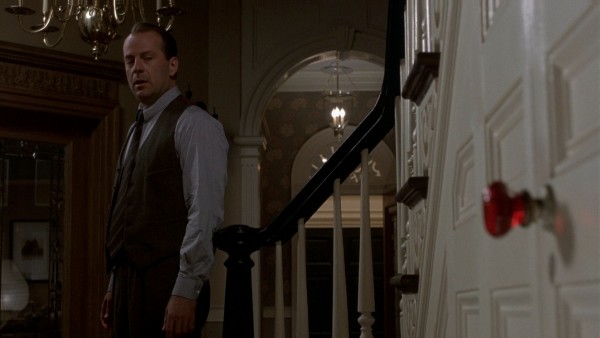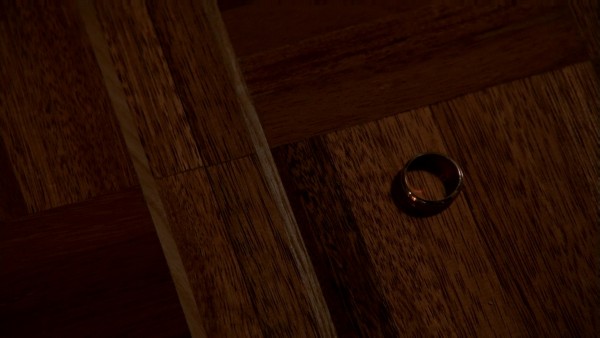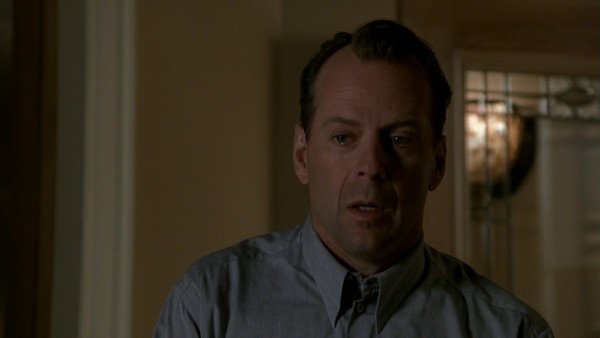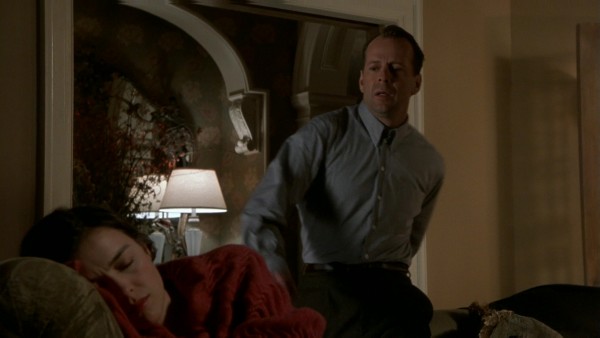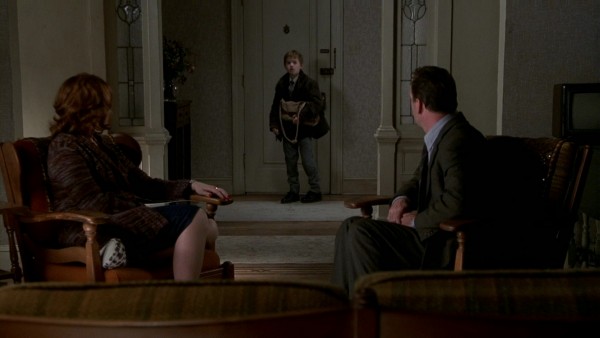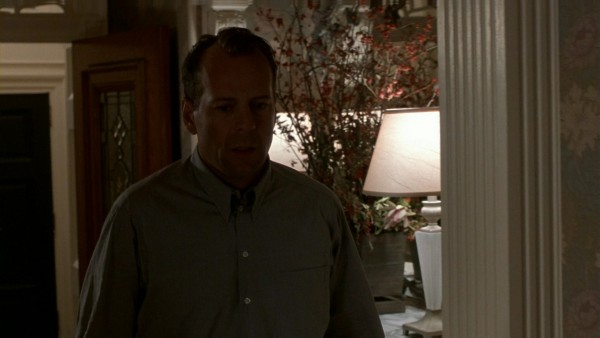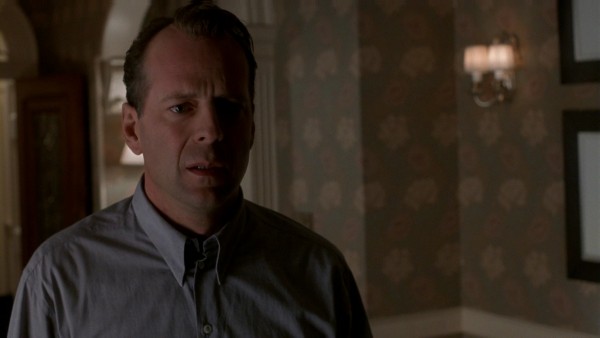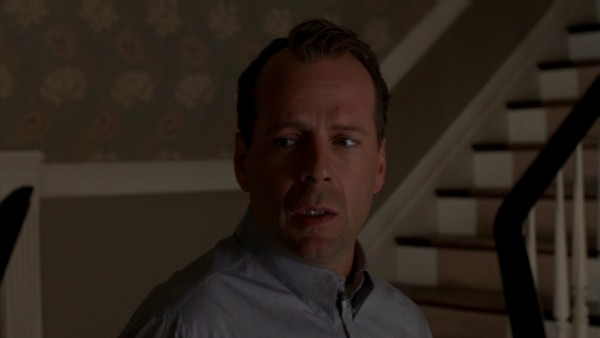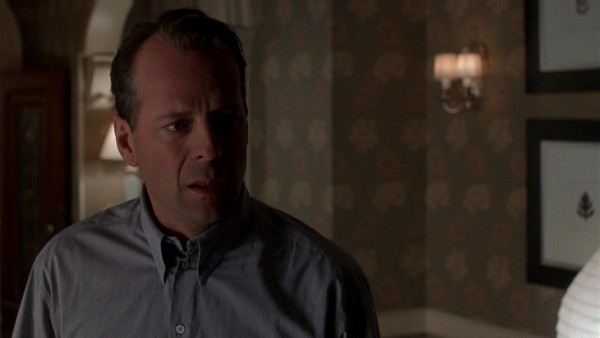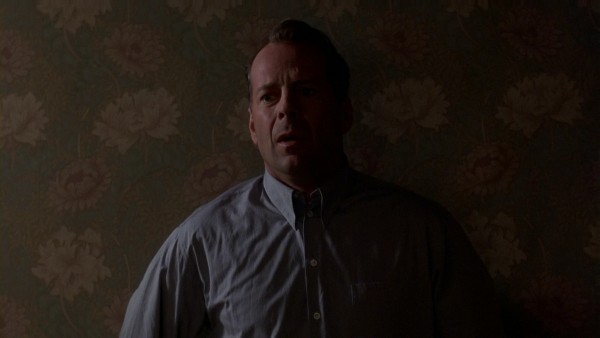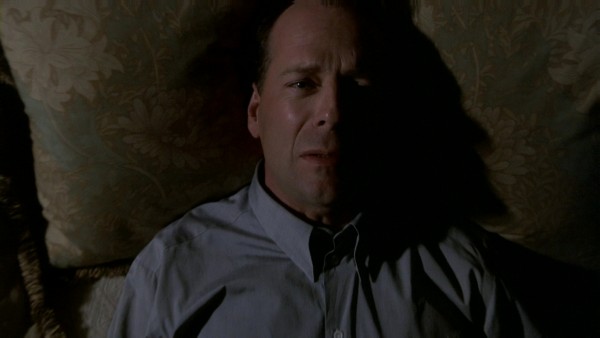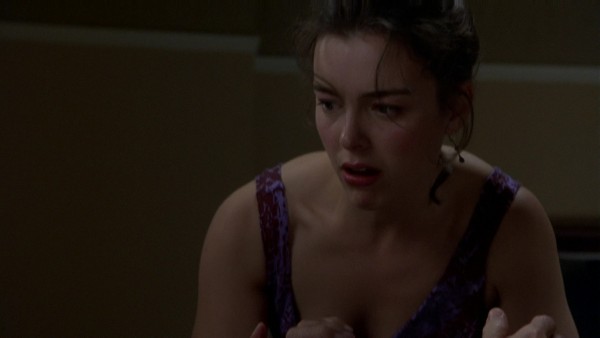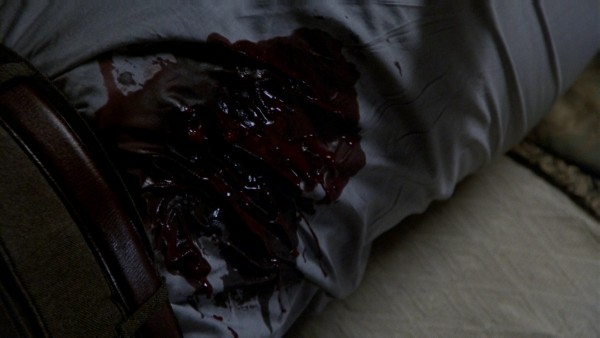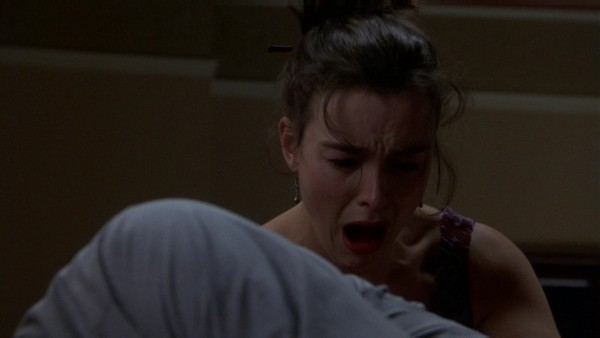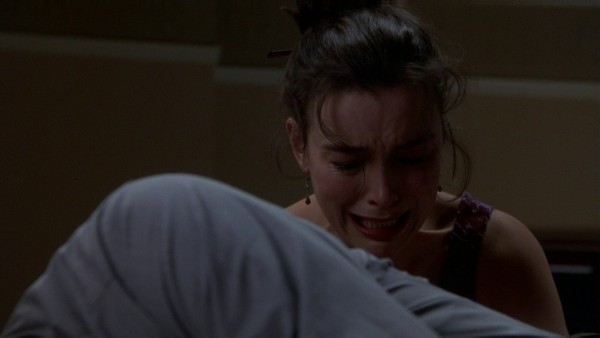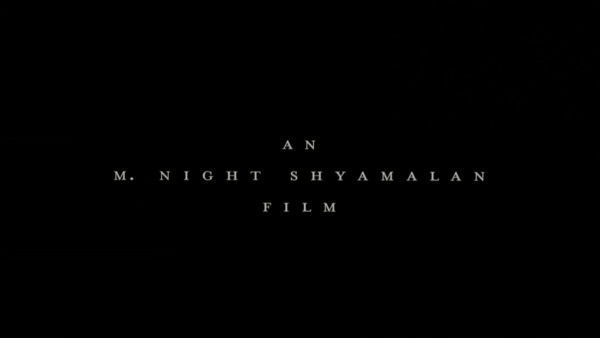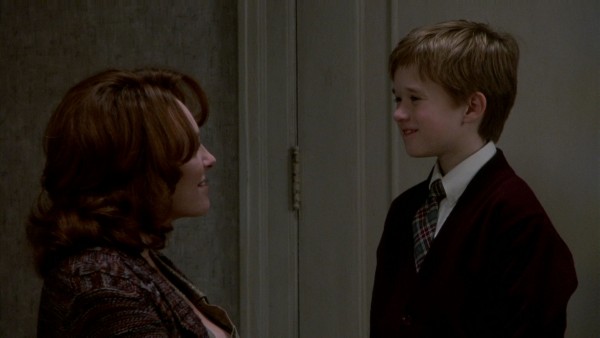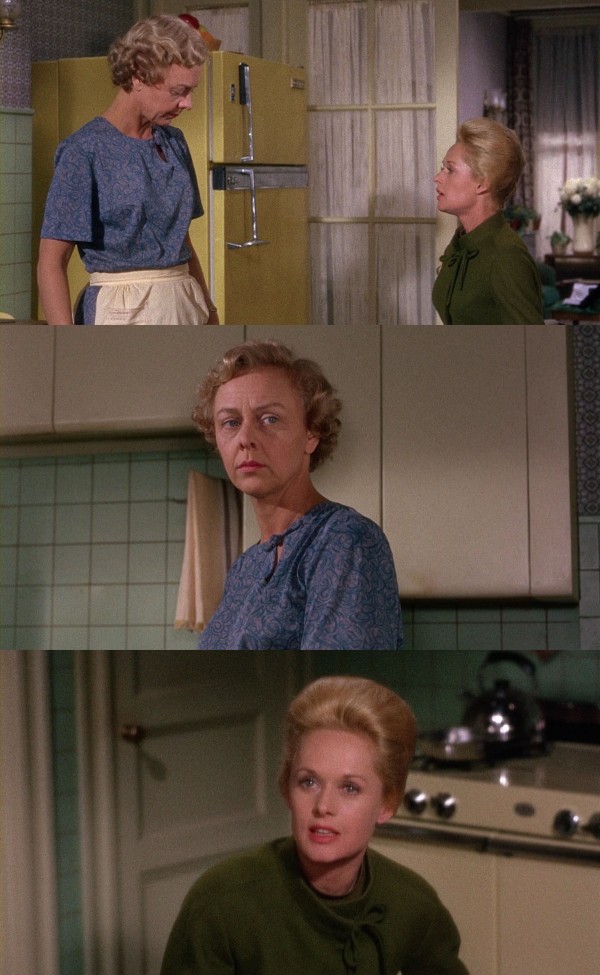
The Sixth Sense, Part II: Beginnings and Ends
This article is part of an analysis project about M. Night Shyamalan‘s five films from 1999 to 2006: The Sixth Sense (1999), Unbreakable (2000), Signs (2002), The Village (2004) and Lady in the Water (2006). This is the second article about The Sixth Sense. The first is here, the third here. The articles about the other films can be found in this overview.
The purpose of this second article about The Sixth Sense is to analyse the opening scene and the last three scenes. (Direct link to each of the latter here, here and here.) The analysis is mostly based on frame grabs, where the captions constitute a running commentary on themes, motifs, shot compositions, and how the various elements fit in with the extensive, over-arching structure of the film. There will be a text segment after the opening analysis, however, to shed light on Shyamalan’s approach to the film’s ending.
For readers unfamiliar with the story of The Sixth Sense, here is a basic outline of the premise.
In order to discuss the film properly, I will have to reveal the whole plot, including the major plot twist at the end.
A walkthrough of an ambiguous wine cellar
We ended the first article with a scene where Malcolm was listening to an old session audiotape in the basement of his house. That was a fitting place to leave off, because we shall now have a close look at the opening scene, where Malcolm’s wife Anna is fetching wine in that same basement. The scene is spearheading a prologue of nearly eight minutes. Here Malcolm and Anna are at home, celebrating that he has received a public citation for his work. Malcolm ends up being shot, however, by a former patient, Vincent Grey (Donnie Wahlberg), who blames him for not having cured Vincent’s mental problems.
The opening scene lasts 68 seconds and comprises only four shots. Without further ado let us carefully walk through it.
In many cases, due to the darkness and detail of some shots, please be aware of the option to click on the frame grabs to enlarge them. Clicking on them yet again will enlarge them even further.
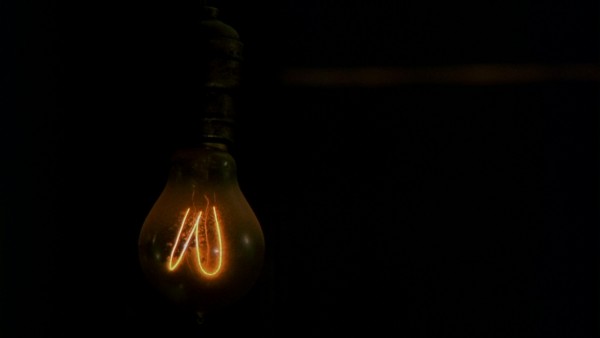








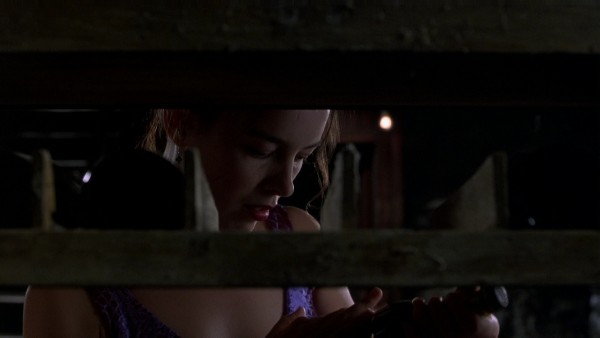
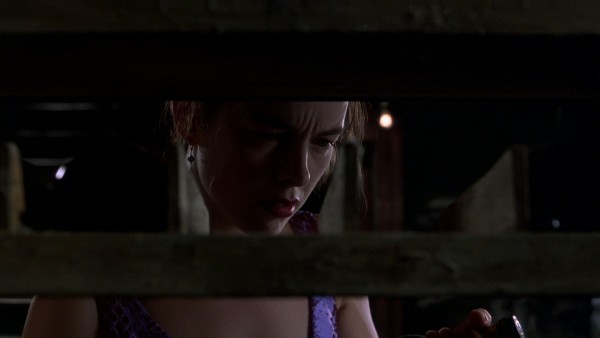






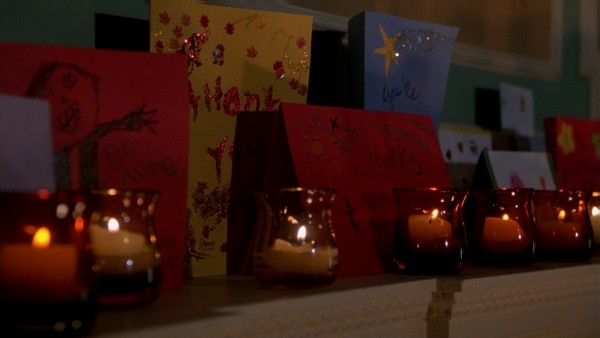
To get an overview of the scene, let us summarise the three last shots.
In fact, the camera placements together exactly represent three sides of a square-shaped box – the walls of the cellar – while Anna herself is always facing one side or another of the box, being “boxed-in”. It would have been neat if the initial close-up of the bulb represented the fourth side, but although it is very hard to determine from the background, judging from the shape of the wire inside it, it looks photographed from the same side as the second shot. But there is an interpretation where it is perfectly logical and thematically consistent that one side should be missing. Please consider the following diagram:
If one interprets the camera as representing something threatening, the diagram becomes outright scary. For it seems that the camera placements make up some sort of encirclement strategy – always shifting one wall to the right – leaving just one wall left, the one closely connected with the staircase, her only possibility of escape. So in our metaphorical reading, she has to run for the staircase, or else she will get trapped in the cellar, and in her own fear, forever.
But let us not get lost in geometry, ambiguity is much more fun. What is the scene about? The literal-minded would shrug their shoulders and say that somehow she sensed that Vincent Grey – who probably broke in a long time ago through the upstairs window – was now hiding in the cellar, beyond that doorway. What she saw on the wine rack was simply clues that he had helped himself to some wine, which could help explain why Vincent was so totally out of control later. When she returned to the cozy living-room, however, she wrote the whole thing off as an attack of nerves.
But surely something much more artful is afoot. I vividly remember from my first viewing how peculiarly unsettling, how quietly electrifying the situation felt, without being able to put my finger on the reason. The eerie atmosphere, the stylised staging, the difficulty of connecting the shots to arrive at a consistent geography of the room, the disorienting refusal at any stage to show us what she is looking at – all point towards metaphor. The scene could be a short film about being afraid of the dark, like Cole’s ghostly visitors may serve as a metaphor for a little boy’s fear of the same. It could be a representation of existential fear – also that consistent with Cole’s story, and his diagnosis of “acute anxiety” – remember Anna’s startled look (of recognition?) when Vincent later asks her “Do you know why you’re afraid when you’re alone?” Furthermore, it could be, before the film specifically connects it to ghosts, a demonstration of what is commonly called the “sixth sense”, an intuition that something indefinable is wrong. Or there could actually have been a ghost in the cellar – later, Malcolm’s ghost seems drawn to it, even setting up office there. Considering their strong bond, it is poetic to imagine that Anna is somehow able to feel the presence of his ghost across time, as if she can feel the future, or if his ghost can travel through time. Anyway, the scene suggests that Anna has a greater affinity than most people for sensing the presence of ghosts, which will be important in the ending, and introduces the fact that ghosts will cause an abrupt decrease in temperature. Finally, the scene is announcing ambiguity, slowness and holding back information as an artistic device. (With her subtlety of expression, the second shot is also a delightful showcase for the peculiar plasticity of Olivia Williams’s face.)
We forgot one detail about the scene – one of those things that films yield on closer inspection and repeated viewings – so let us backtrack a bit to the last shot.
They are closely grouped together and the only ones that are red. They must be lit from within or digitally enhanced, or else they should have appeared as much darker – so they must have been intended to be seen. The caps seem to fit the motif of thrice-occurring elements, and definitely the colour red motif, connected to the appearance of ghosts. Could those caps, on some level, be what she saw on the shelves and made her turn around? (Incidentally, if you scroll back up a little, to the first shot of the living-room scene, you will see that there are three red greeting cards in that shot, and that the three rightmost candle-holder glasses are grouped together and have a reddish hue.)

For she is positioned right beside the red doorknob of the cellar door. (In similar fashion to when she was standing close to the wine rack, see just above.) We will see this knob several times later in the film when Malcolm is wrestling with the door to open it. The red refuses to let Anna go, for as we can see when the couple have sat down, the doorknob remains visible for quite a while in the background not far away from her. The cellar door is even slightly ajar, as if to emphasise that dark forces may still be at large. Furthermore, in the background we see both the cellar door and the staircase leading to the bedroom where Malcolm will be shot – like portals to dangerous places and to the previous/next scene – their visibility in the shot is not a coincidence. And when the cellar door eventually gets excluded, the staircase always remains in the background, pointing into the future. (In the third article we shall examine Shyamalan’s adeptness at using backgrounds to such subtle effect.)
The above business about red and backgrounds may sound very esoteric, but serve as good examples to show the extreme care and tight control M. Night Shyamalan is displaying in his mise-en-scène and shot compositions. We shall round off this chapter with a high-level view of the entire prologue. It starts in the cellar, continues in the living room at the ground floor, and ends in the bedroom upstairs. This “heavenward” ascent is not only thematically meaningful, but the first among a multitude of foreshadowings or indicators during the rest of the film about Malcolm’s real nature – that he was in fact killed by Vincent and is now a ghost who thinks he is still alive. But there is more:


This last shot is interesting in other ways. My impression is that Shyamalan is playing with our unconscious here: the shape of the greenery area leads my thoughts to a coffin, something that is reinforced by the framing of the black fence, like the black borders traditionally used for photographs of the deceased. Even though green usually represents life, the fact that Malcolm is only seemingly alive fits fine with the green-enclosed-by-black constellation. Furthermore, it is precisely Malcolm sitting there on the bench, waiting for Cole to come out of a house on the other side. Since Malcolm is dead it is symbolically perfectly logical that something representing death should function as a visual barrier. The same barrier continues to be in play when Cole soon tries to run away from Malcolm, who chases after the boy, each on their own side of the barrier.

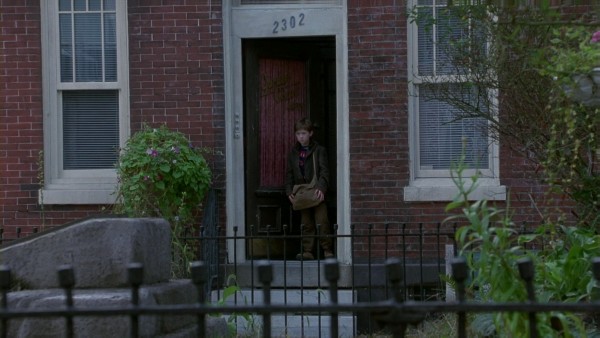
The three endings
“Observe: The magic penny. Looks like an ordinary penny. But I do my little magic shake, and… now it’s in my right hand. But that’s not the end of the magic trick. I do another little shake, and… [it’s] right there in the vest pocket. But that’s not the end of the magic trick. I do another little shake…and… [it’s] right back in the left hand where it started.”
After Cole’s confrontation with his teacher, “Stuttering” Stanley, Malcolm tries to lighten his mood by performing a silly magic trick. Malcolm’s monologue, quoted above, could serve as Shyamalan’s credo as regards his trademark plot twists. They are not always limited to one per movie, at the end. In The Sixth Sense there are three major events which send the film careening in a different direction: Vincent Gray shooting Malcolm at the latter’s night of celebration; Cole confiding in Malcolm that he is seeing ghosts; Malcolm realising he is a ghost himself. The two latter are genuine twists, redefining what we have seen before.
Even more fittingly, Malcolm’s speech could be applied to the three different endings of The Sixth Sense. Its last three scenes – Cole and Malcolm bidding farewell after Cole has made decisive progress; Cole finally telling his mother, too, that he is seeing ghosts, resolving their difficulties; The dead Malcolm reassuring his wife that she was “never second”, thereby giving them both peace – all three scenes are marked by finality, redemption, resolution, closure. And the last scene is indeed “right back in the left hand where it started”, since it is inextricably intertwined with the very beginning of the film.
It is not that difficult to imagine the film ending after both the first and second of these scenes. But it is “not the end of the magic trick”. Furthermore, the tonality of the endings is very different. It is almost as if Shyamalan has set out to demonstrate various ways of ending a movie. The first one is the typical Hollywood ending: the two protagonists part ways, both smiling and happy, without any disturbing undercurrent except for a standard “smiling through tears” device – their decision to pretend they will meet again tomorrow. There is also the standard device of repeating a previous phrase, but with a new and humorous twist to provide the audience an easy way of appreciating how much the characters have changed: “I thought Tommy Tammisimo sucked big time.” Finally, this is the only moment in the film where the music verges on the saccharine.
It is not that Shyamalan has set out to make a bad scene – it works fine in its way – but there is a certain glibness and predictability almost not worthy of a film like The Sixth Sense. It is almost as if Shyamalan is saying to the audience: “Well, that is the type of ending you usually get in a mainstream Hollywood film, but now I am going to show you the real thing.” So we get the scene in the car, quivering with absolutely truthful, raw emotional power. With the audience still reeling, the mood yet again changes abruptly – “that was the emotional ending, now for the intellectual one.” After a quiet start, the viewer is soon subjected to a rush of information that has to be pieced together quickly, while we, as bewildered as Malcolm, are trying to cope with the rapidly piling up of evidence that Malcolm has been a ghost all along.
So there is a crescendo of plot connections to be made. There is also a cascade of redemptions, resolutions and closures. All the while, as the three endings grow progressively longer and more complex, there are an unusually large number of motifs, phrases and situations from earlier stages of the film that will reappear, something that adds even more to the general sense of coherence and finality.
Those reappearances will be dealt with as we discuss each ending on an individual basis. Let us now talk about redemptions and resolutions. During the dinner scene Cole’s mother utters another line that can be said to be emblematic for the whole film:
“I mean, I’ve been praying, but I must not be praying right. Looks like we’re just gonna have to answer each other’s prayers.”
This is exactly what happens during the three endings, where the characters are virtually lining up to help resolve each other’s guilt and problems.
- In the first ending, Cole and Malcolm provide important advice to enable each other to be instrumental in this process. Cole tells Malcolm that he may be able to communicate with his wife by talking to her while she sleeps. Malcolm encourages Cole to come clean with his mother about his ability to see ghosts.
- In the second ending, the resolutions start. All four characters of the film’s two difficult relationships will end up co-operating in resolving each other. When Cole tells Lynn about the ghosts, her honesty when saying that she would never think of him as a freak, encourages him to say that he has been in contact with the ghost of his grandmother. The message he relays from her that she is proud of her daughter Lynn “every day”, resolves Lynn’s lack of self-belief and probably also guilt over having had a difficult relationship with her mother. In the end, Cole and his mother join in an embrace one feels will wholly resolve their difficult relationship.
- In the third ending, Malcolm frees Anna from her depression by telling her in her sleep that “You were never second,” and also by giving her an opportunity to say a proper farewell. Anna herself has played a part in Malcolm’s resolution (and consequently her own) by dropping the ring, setting in motion Malcolm’s gradual realisation that he is a ghost.
So all four major characters are given the opportunity to move on to a new, improved plane, and everyone has helped. This is already a pretty solid foundation of unity and coherence, but there is more.
- Through Cole’s action of delivering the videotape evidence about her murder, Kyra is set free from her ghostly existence. (Cole confirms to her little sister, who has probably seen Kyra’s ghost too, that she will never come back.)
- One must assume that Cole’s grandmother is also set free, after he has delivered her message of pride to his mother.
- Kyra’s ghost has helped set Cole free by appearing in his house, his first step of coming to terms with his powers.
- Malcolm has also helped set Cole free by discovering the key idea, “They just want help, even the scary ones. I think I might know a way to make them go away…. Listen to them.” At the same time, helping Cole was a necessary step for Malcolm to be freed himself.
- The ghosts of Kyra and Cole’s grandmother would themselves never have been freed without their own actions, which at the same time help others.
Everybody is interconnected, in a vast web of closure and mutually beneficial co-operation. One could even say that Kyra’s father has been helped, however brutally, by the opening of his eyes to the murderous nature of his wife, something that frees him from the illusion that his daughter died of an incurable illness. Not to speak of Kyra’s little sister, who seemed next in line for murder.
So there is a strong feeling of thematic unity in The Sixth Sense. Let us briefly consider some other contributing factors. All of the four main characters have something in common: they strongly miss another person.
- Malcolm misses his wife.
- Anna misses his dead husband Malcolm.
- Cole misses his father.
- Cole’s mother Lynn misses her own mother.
Sleep is also important. All three main characters who are living beings are helped to sleep, or calmed during their sleep, by others.
- Malcolm is staying by the hospital bed until Cole falls asleep.
- Malcolm is also calming Anna’s distressed sleep in the third ending.
- Cole is calming his mother during her nightmare about Cole being hurt. This last event is especially important, since it comes directly before the appearance of Kyra’s ghost. The fact that he was able to soothe his tormented mother seems to inspire him to overcome his fear of the ghosts, so that he can start listening to what they want.
The doors of the ghost world and the lamps of loneliness
Before delving into the endings, it might be fruitful as preparation to have a brief look at two strands of symbols/motifs, namely doors and light sources. As we saw earlier, an indicator of their importance is that a light bulb and the opening of a door are the first objects we respectively see and hear in the opening scene, and heavily connected because the door is opened exactly when the light bulb is at its brightest. Remember also that Anna was shown with the light bulb beside her for most of the second shot, and Vincent’s line to her, “Do you know why you’re afraid when you’re alone?”, is one of the many things that connect loneliness to light sources.
There are two slide shows about doors. The first one shows examples of how doors are connected with ghosts. Fittingly, the first ghost appearance in earnest, the furious suicide victim in the kitchen (spitting out, “No, dinner is NOT ready!!”) is setting the stage: in a 24-shot scene, where except for two establishing shots, a close-up of a thermostat and some character close-ups, all shots have doors and doorways in them. Shyamalan even contrives to include doors in the long shot of the ghost in the kitchen, because her favourite thing is opening doors of closets and cupboards. The second show is about Malcolm’s connection with doors. (It is placed below the discussion of lamps to avoid the visual distraction of two slide slows running simultaneously.)
Now for a look at some lamps. Four of the five example shots follow each other closely during the same sequence, the succession underlining the lamp motif. In the first example Malcolm is coming home. Further down the street, on a landing similar to the one Malcolm will use to enter his house, there is a couple embracing. Considering this being a film set and Shyamalan’s track record of using backgrounds, they are intentionally put there for a purpose, probably to mildly accentuate Malcolm’s ruined relationship to Anna.


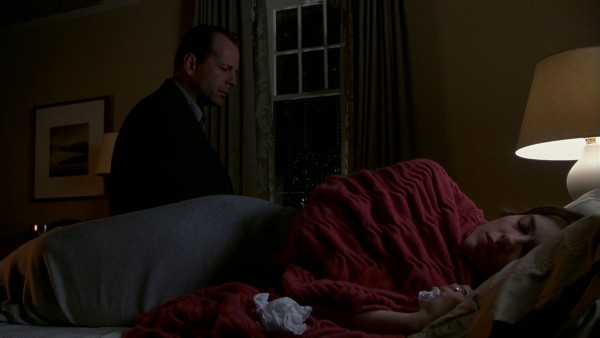
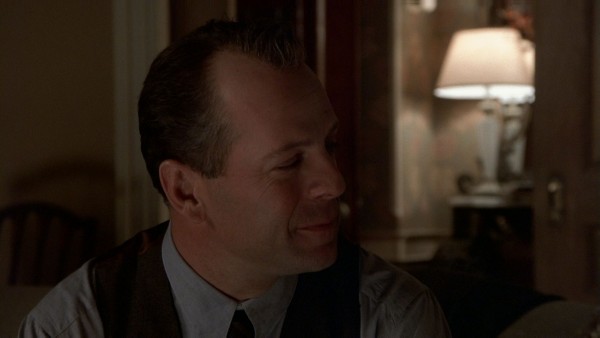
We end this small survey with some shots of Malcolm and doors. His door business is mostly to do with the door to the house and the cellar door. (When we see him entering in the lamp shot above, he is only coming out of the door – we almost never see him go all the way through doorways in the film, possibly to avoid connecting him to closely with the other ghosts, protecting the twist.)
The first ending: “I’ll see you tomorrow”
Here Cole and Malcolm bid each other farewell, right after the boy’s triumphant starring role in the school theatre production of “Young King Arthur”, and the exquisite humiliation of the detestable Tommy Tammisimo, relegated to the role of the village idiot. (In fact, that scene contains yet another ending, the end of the play.) We have already mentioned several aspects of the scene, for example their important advice to each other. To expand a bit on their conceit pretending they will meet again tomorrow, this is probably a wistful reference to Cole’s own, absent father, whom Malcolm has come to replace as a father figure. One of many indicators of this is that like Cole clings on to left-behind items of his father – for example glasses, gloves, a watch; even his all-important red tent uses golf clubs as tent poles – Cole adopts Malcolm’s phony magic trick, which he shows to his sullen classmate during the birthday party. The situation gets added resonance due to the fact that The Sixth Sense was shot in sequence (on Shyamalan’s insistence), so this is the last scene where Osment and Willis acted together.
The scene is short (110 seconds) and quite simple. The heavy lifting of finality-creating references to previous stages of the film has not quite started yet, and in this aspect the scene is about par for mainstream films. But there are a few things worth mentioning. Cole’s sudden elevation to stardom – which amusingly reflects Shyamalan’s own trajectory after this film – forms a gentle closure to the daydreaming game Cole used to play with his mother: “I was picked first for kick ball teams at recess. I hit a grand slam to win the game. Everybody lifted me upon their shoulders and carried me around, cheering.” The last part became literally true.
At the end of scene they only nod knowingly to each other, having achieved total understanding. They have traveled far since the total failure of the mind-reading game.

The second ending: “Grandma says hi”
Here Cole finally tells Lynn about his ability to see ghosts and finds an irresistible way to convince her. This is easily the film’s most moving scene, in large part due to Toni Collette‘s brilliant, heart-wrenchingly honest performance. (It was precisely this scene that convinced her to take the role and similar to the previous scene, the last scene shot between them.) But, as in the dinner scene, one still marvels at 10-year-old Osment’s ability to flawlessly participate in long takes, like in the end segment of the first shot here.
The scene is governed by two personal journeys. Armed with his new-found confidence and insights into the ghost world, Cole is now relentlessly pursuing his goal of being completely honest with his mother. Lynn’s journey is longer and much more tumultuous. In the car she starts out sounding rather complacent, almost smug. For even with all the verve and warmth with which her character is painted, there is still a faint air of neglect, or maybe just denial, about her relationship to Cole. She does not seem to think twice about Cole’s many scratches and, even though her stress is understandable, ends up scolding him at the dinner table, an irritation one feels is initially awakened by Cole using her ex-husband’s gloves at the table. In addition, she somehow perpetuates her own mother’s refusal to attend Lynn’s dance recital as a child. Her tone is so disinterested that one even doubts she really means it, when she says she would have given “anything to have been there” when they talk about her absence.
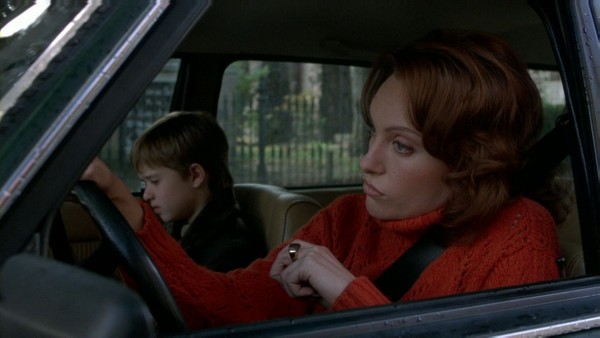

At the end of the scene though, we suddenly realise that many of her own problems spring from a lack of approval from her dead mother. This insight strikes the viewer like a hammer blow, and Collette’s performance is so spontaneous and unforced that one is filled with fresh wonderment that human beings think these things are so important. The scene is given an especially resonant tenor by the fleeting appearance of the traffic victim’s ghost outside the car window. Another brilliant idea, lending freshness and immediacy to the scene, is the fact that Cole’s communication from his grandmother is meaningless to him, and us, until the very end of scene, because he does not know the question that his grandmother is replying to.
The scene’s direct emotional resonance is augmented by a considerable number of references to previous scenes, conjuring up more or less conscious emotions and ideas from the viewer’s memory. Many of the links are in the dialogue. This article, however, is supposed to lean heavily on visuals. And, although there are less obvious nuances, these links are rather clear – of the “Tommy Tammisimo sucked big time” type, intended to be consciously noticed. Nonetheless, for the sake of completeness the dialogue links are given in this addendum.

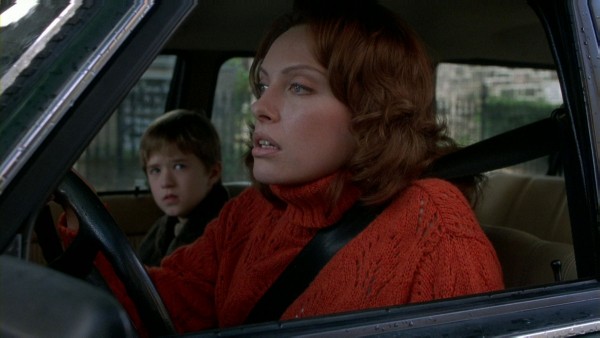




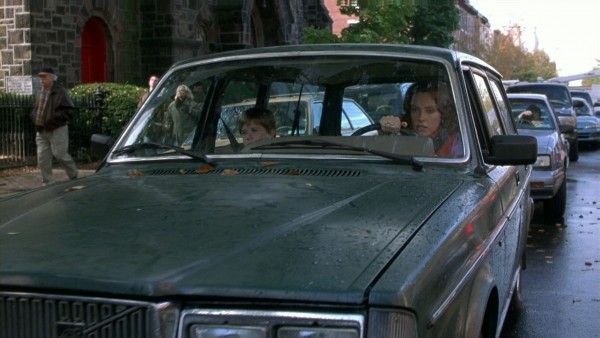





The third ending: “You were never second”
To avoid interrupting the flow of the story, I have chosen also to include images that do not have any particular interpretative value nor any need for explanation.Unless otherwise noted, the analysis contains frame grabs of all the shots. Only pertinent dialogue has been included.
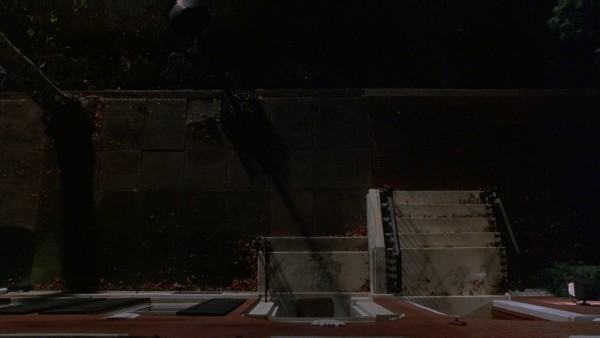


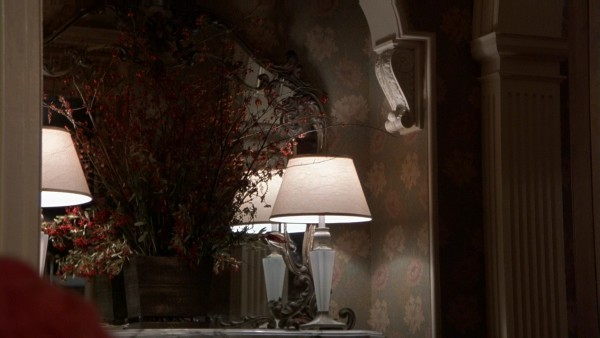
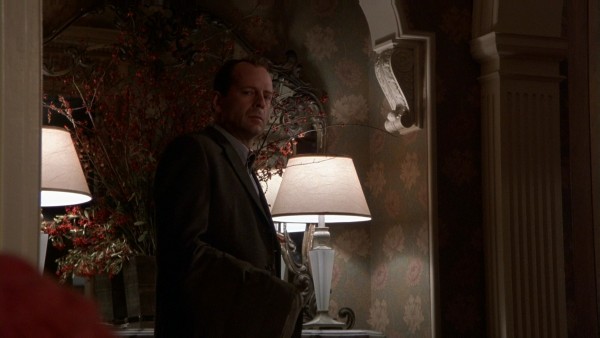
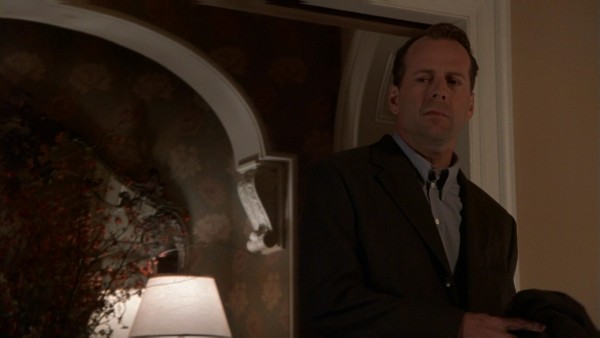


We will leave out the next eight shots, which go back and forth between the two, during which the following conversation takes place:
Malcolm: Anna?
Anna (after a long pause): I miss you.
Malcolm: I miss you too.
Anna: Why, Malcolm?
Malcolm: What? What is it?
Anna: Why did you leave me?
Malcolm: I didn’t leave you.

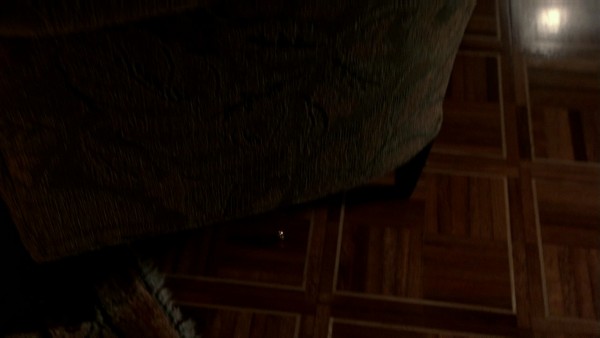
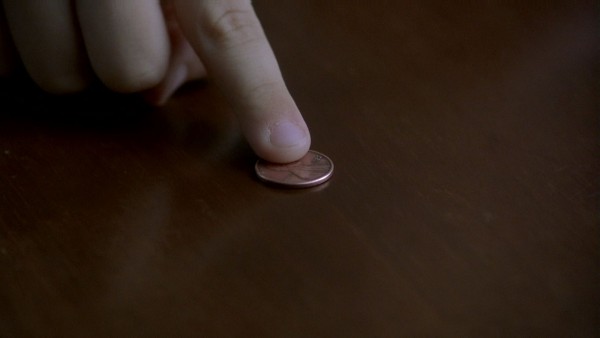

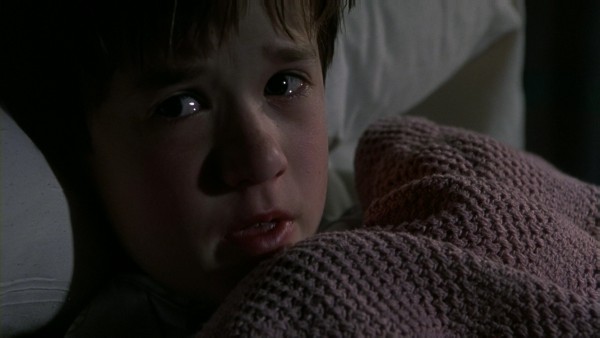

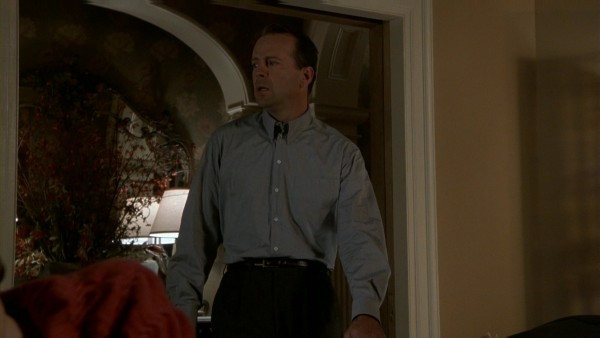
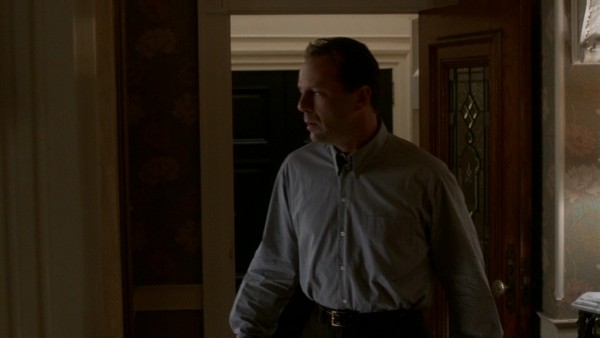



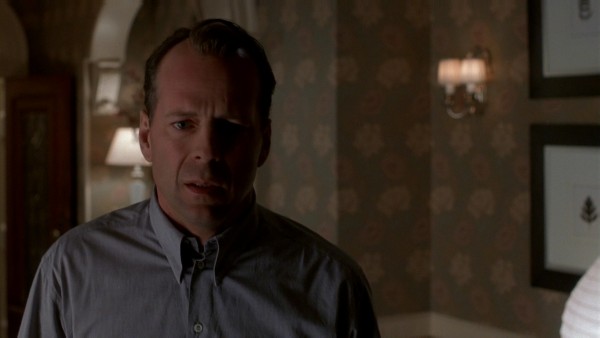
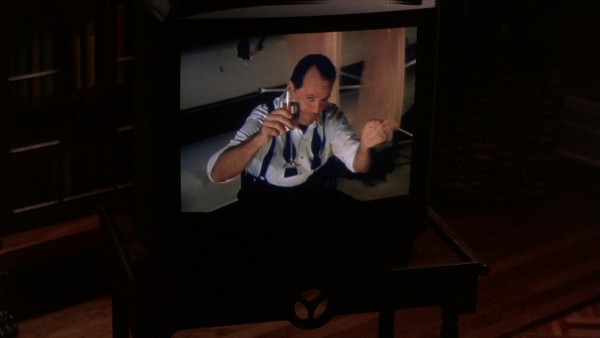







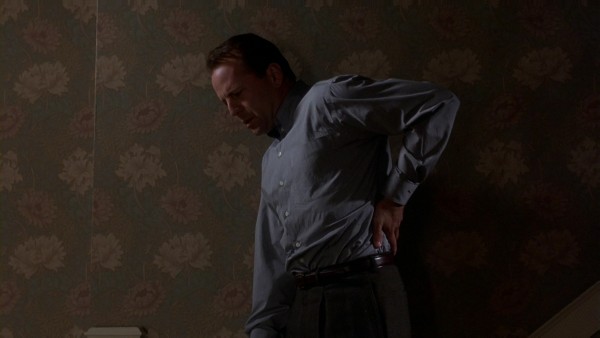


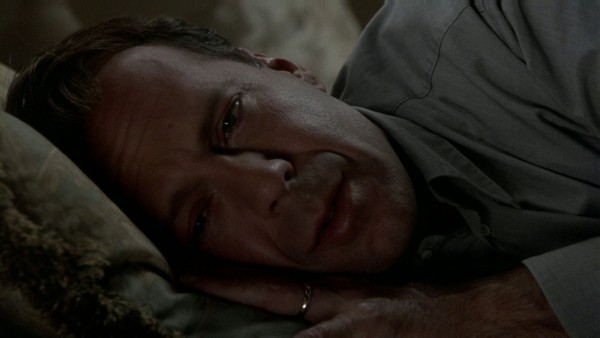
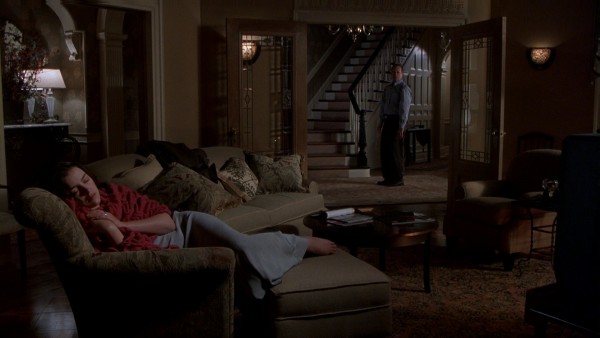

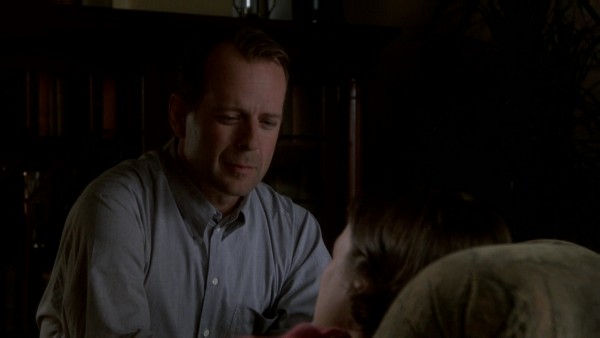

I can go now. I just needed to do a couple things. I needed to help someone. I think I did. And I needed to tell you something. You were never second. Ever.”
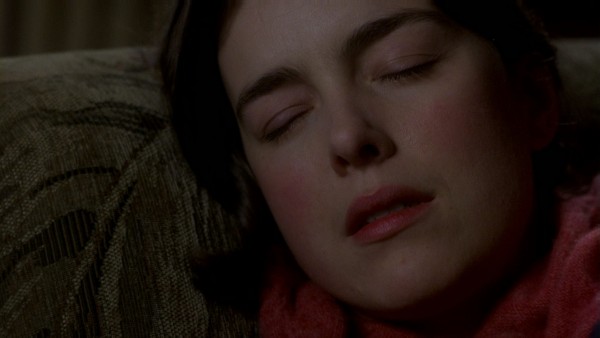
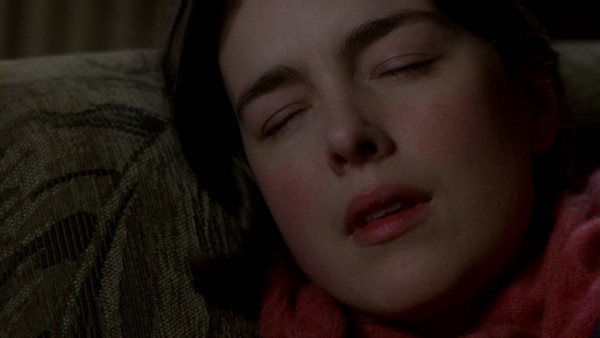


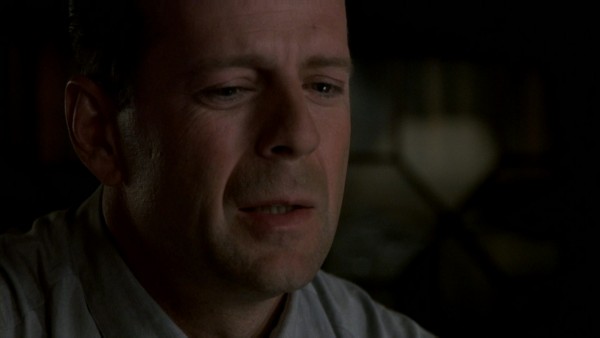

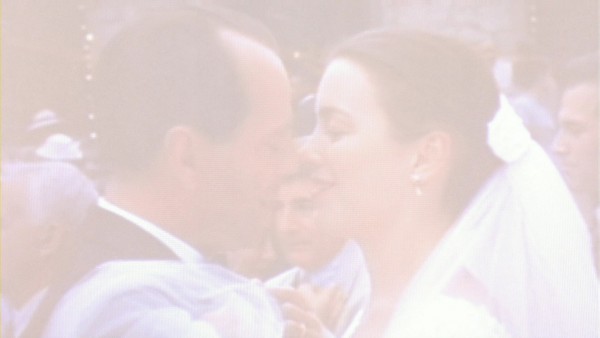
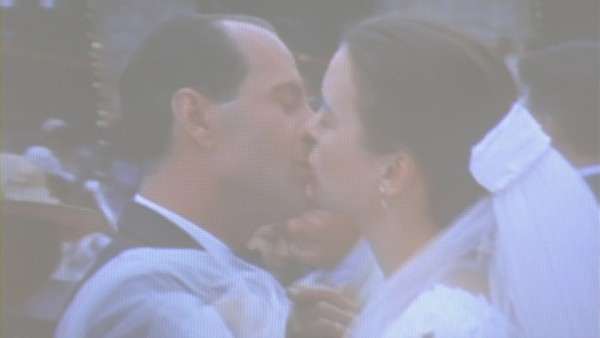

But there is more coherence, completeness and closure. Incidentally, one form of completeness arises out of the formal device of the fades we just saw, because the film fades away both into whiteness and darkness, and what can be more complete than that?


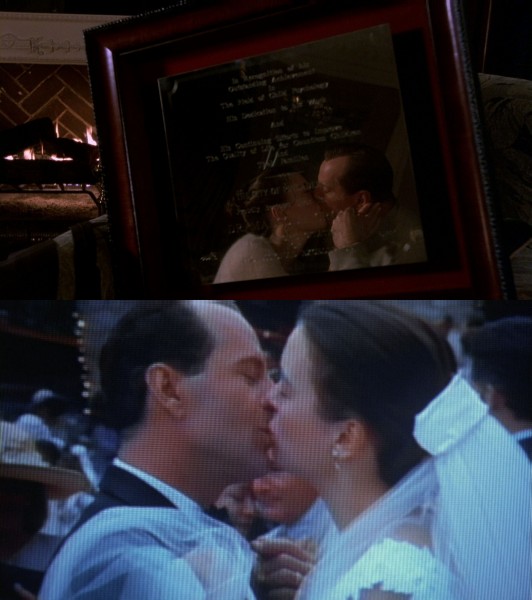



The musicologist Richard Middleton describes form (quoted from Wikipedia):
…through repetition and difference: difference is the distance moved from a repeat; a repeat being the smallest difference. Difference is quantitative and qualitative; how far different and what type of difference. According to Middleton, musical form is “the shape or structure of the work.” In many cases, form depends on statement and restatement, unity and variety, contrast and connection.
M. Night Shyamalan has orchestrated The Sixth Sense with a definite sense of musicality. This analysis has attempted to capture “the story behind the story”, how elements of a more covert nature tell a parallel version of the story of these characters. Forming a supporting structure for the overt narrative, they affect the audience on an unconscious level, at a depth that traditional storytelling alone may be unable to reach.
*
Addendum: Dialogue links in the second ending
We are here going to briefly discuss the many references in dialogue in the second ending to the rest of the film. The most direct link, of course, points back to the similar “I see dead people” scene. Cole says to Lynn “I’m ready to communicate with you now,” which invokes the line “I wanna tell you my secret now,” in the first scene, but the much more grown-up phrasing speaks volumes about Cole’s development. Cole follows up with “Tell you my secrets,” linking even more strongly to the previous scene and also to the film’s important word “secrets”. (“Communicate” also links to Malcolm’s wife’s explanation to the Indian couple in the antique shop about the sapphire ring, as if Cole is like a medium that can pass on things, like the ring.) In both scenes, it is notable that the tone of Malcolm and Lynn’s questioning of Cole is quite similar.
Cole says, “What are you thinking, Mama? You think I’m a freak?” “Freak” is another important word, and the thing he has been most afraid of is that Lynn would look at him the same way as his taunting schoolmates. Vincent Grey, too, describes himself as a freak (subconsciously triggered by Malcolm guessing that Vincent may be called Ben Friedkin).
Lynn answers, “Look at my face. I would never think that about you. Ever. Got it? Cole: “Got it”. This connects directly back to two other situations:
- The breakfast scene: Cole: “Well, what are you thinking, Mama?” Lynn: “Lots of things.” Cole: “Anything bad about me?” Lynn: Hey, look at my face. I was not thinking something bad about you. Got it?” Cole: “Got it.”
- The scene after the dinner quarrel: Cole: “If you’re not very mad, can I sleep in your bed tonight?” Lynn: “Look at my face. I’m not very mad.”
“Think” is another important word. After Lynn has confirmed his belief in Cole, she seems to falter in the face of the supernatural and ghastly nature of Cole’s problem. She says, “Just let me think for a minute.” By its very similar wording, this seems intended to directly reference the scene where a confused Malcolm tries to recollect who Vince Gray is, when he says “Just give me a minute to think.”
“Think” in the meaning of guessing other people’s motives and inner thoughts, is also important. The whole mind-reading game between Malcolm and Cole is centred around it, accentuated by Cole’s piercing question at the end: “What am I thinking now?”. Other instances:
- Lynn to the suspicious doctor: “You think I hurt my child? You think I’m a bad mother?”
- Malcolm to Cole: “You think I’m sad? What makes you think that?”
Incidentally, the breakfast scene contains an obvious reference to Hitchcock’s Marnie (1964). Cole’s line to his mother, “Well, what are you thinking, Mama?”, is very similar to Marnie’s “Hmm. What are you thinking now, Mama?”. Both scenes are early in the films, introducing the mother, take place in a kitchen, between a mother (standing) and her offspring (sitting at the table), in families without a father and with great communication problems. In both scenes the question has to do with the mother’s judgement on problematic behaviour. (When first seen in the films, both Marnie and Cole are carrying a bag.) That The Sixth Sense should reference this famous predecessor is not that strange, since the colour red is of utmost importance in both works.

